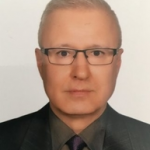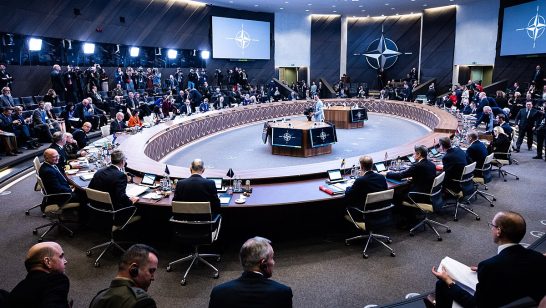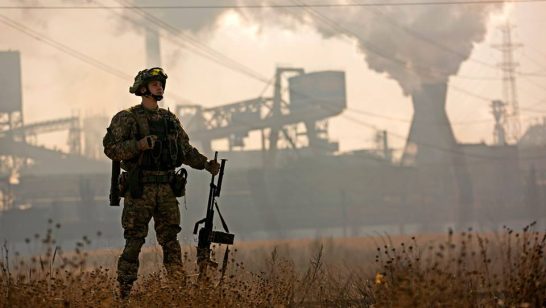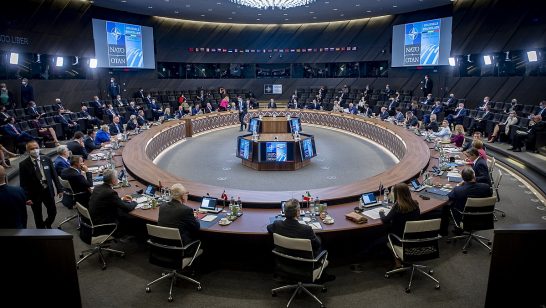
The common wisdom of many Western leaders and analysts in the post-Cold War era was that Russia seemed to have metamorphosed into a cooperative partner. The idea of having Europe whole, free and at peace, including Russia, had been the driving vision that shaped the foreign policies of the Western community of nations.
The first blow to Euro-Atlantic security was dealt in 2008 through the Russo-Georgia War, and hopes of Russia as a cooperative partner ran aground. The next stop was the illegal occupation and annexation of Crimea in 2014 by Russia and the destabilisation set in motion in Donbas, now declared by Russia as “Russian territory”. The last fatal blow came in February 2022 when Russia launched its so-called “special military operation” to “de-Nazify” and disarm Ukraine.
Despite a flurry of NATO and EU Summit decisions – including sanctions imposed on Russia and military and financial support for Ukraine – Russia continues to wage its full-scale invasion of Ukraine uninterrupted. It has turned into a war of nerves as much as a war of values with no immediate end in sight. Hence, the initiation of a primarily two-pronged approach by Western Allies and partners consisting of sanctions on Russia and supporting Ukraine “for as long as it takes and as intensely as needed,” in the words of the most recent EU Summit Conclusions of 21-22 March 2024.
The fundamental challenge the Allies now face is how to stop Russian aggression and reverse it in a manner that will make it impossible for Russia to launch a similar attack against Ukraine again or any other country. As things stand now, it is important to debunk the so-called “Ukraine fatigue” in the West. The fundamental objective should be to demonstrate further perseverance, resolve, and resilience, primarily by aiding Ukraine in restoring its territorial integrity in the long run. That requires giving way a priori to a conceptual frame for peace designed to end the ongoing war in Ukraine.
It is encouraging to see a reference to achieving peace at the last EU Summit conclusions, incorporating the principles and objectives of Ukraine’s Peace Formula of August 2023 with a view to a future Global Peace Summit. Extending EU membership to Ukraine in the long term cannot be a recipe to stop the war now. Neither would it be possible to satisfy the current expectations of Ukraine to benefit from the two clauses of the Lisbon Treaty, that is, the military assistance and solidarity clauses, as a solid security guarantee for Ukraine. Had those clauses been sufficient to stop Russian aggression, Finland and Sweden would have stayed their course and not applied for NATO membership.
Under such circumstances, Ukraine perceives NATO membership as the real security guarantee, thus placing itself under the guarantee of collective defence under Article V. Given the ongoing lack of consensus within NATO, whether such an option is attainable on the 75th anniversary of the Alliance is still elusive. The Biden administration has made it clear it has no intention of directly confronting Russia in Ukraine. President Macron’s recent remarks about putting boots on the ground to fight Russia have sent tremors throughout Europe and beyond.
The suggestion by the former Secretary General of NATO, Anders Rasmussen, to take a divided Ukraine into NATO runs against the principle of the study on NATO enlargement adopted in 1995. It states, “States which have ethnic disputes or external territorial disputes, including irredentist claims, or internal jurisdictional disputes must settle those disputes by peaceful means in accordance with OSCE principles. Resolution of such disputes would be a factor in determining whether to invite a state to join the Alliance.” The main downside of Rasmussen’s proposal is the risk it poses of escalating the war by directly involving the Alliance. It is also made at a time when the spectre of a Trump administration haunts the skies of Europe, including Ukraine. Hence, the clear remark by NATO Secretary General Jens Stoltenberg in December 2023 that “we all agree Ukraine will become a member of the alliance”. But, “to become a member in the midst of a war is not on the agenda.”
It is also evident that despite visible support behind it, President Zelensky’s 10-Point Peace Plan of August 2023 has, so far, not garnered sufficient traction to stop Russian aggression. It is, therefore, high time to ponder on the potential ingredients of a compromise for Ukraine that could be grounds for a future Global Peace Summit.
Several reflections for a potential peace deal could be clustered in the following terms:
Territory: The thought of taking a cue from the Finno-Soviet Treaty of April 1948 is a non-starter since it stipulated ceding Finnish territory to the Soviet Union in exchange for Finnish neutrality. After spending so much blood and treasure in Ukraine, it would be naïve to expect Ukraine to agree to cede territory to Russia. That does not, however, prevent the need for exploring means of achieving a verifiable truce with Russia with the proviso that the occupied Ukrainian territory grabbed by Russia would be put under a temporary status until negotiations on peace terms are finalised. This should be done with the clear understanding that the aim is not to create another frozen conflict within Ukraine but to provide a breathing space for Russia. Accordingly, the international community must make it clear that it will not recognise the Russian decision of annexation of the occupied Ukrainian lands.
Similarly, the deal reached between the Western powers and the Soviet Union on the division of Germany after the Second World War cannot set a precedent for deciding the future of the Russian-occupied lands. Neither is the truce achieved that still holds after the Korean War applicable to a Ukrainian settlement. Both of those arrangements involved people of the same nation, whereas Ukraine is a country with a separate identity and nationhood. Thus, a sui generis arrangement will be essential while negotiating a truce.
Both of those arrangements involved people of the same nation, whereas Ukraine is a country with a separate identity and nationhood. Üzümcü and Ceylan
Reframed negotiation structure: A reframed negotiation structure for a truce and an ensuing peace deal should be conceived. It should include the US (hinging on the outcome of its Presidential elections this year), the UK (as one of the guarantors of Ukraine stipulated by the Budapest Memorandum of 1994), Japan and India from the Asia-Pacific, the EU as the initiator of the Global Peace Summit, Türkiye as a facilitator in the region, and China as a global actor which undoubtedly suffers from disruptions in particularly supply and value chains.
Negotiations part of a broader multinational frame: If and when a truce is achieved for the ongoing war, including its nuclear threat dimension, subsequent peace negotiations should be part of a broader multinational frame transcending the transatlantic community. The stakeholders identified above should extend security guarantees to Ukraine on bilateral, multilateral, and multinational tracks. NATO, the EU, and SCO could be involved in the multilateral frame, whereas the UN should be the bearer of layered regional and global security guarantees. Such an architecture of guarantees would make any peace initiative a truly global enterprise.
Nuclear weapons and conventional arms control: To reinforce the truce process leading to an enduring peace deal, the US should reintroduce a nuclear disarmament proposal, like it did before the war broke out, in exchange for negotiations with Russia. The US should also ensure that it commits itself to not deploying nuclear capabilities in Ukraine for an indefinite period, and Russia should withdraw its nuclear assets from Belarus.
The Allies and Russia should commit to starting negotiations on conventional arms in Europe (an entirely new treaty), taking into account the post-war situation and mutually agreed-upon priorities. This issue should be included as a component of a global peace deal. Opportunities should also be explored to sign a renewed Founding Act between NATO and Russia to cater for the needs of a post-war epoch without prejudice to the commitments and obligations of the UN Charter and international law.
It should be made clear to the Russian side that commitments under a truce would be reversible if Russia violates them and seeks ways of circumventing them to its military advantage. An elaborated version of this clause should be part and parcel of any broad multilateral arrangement.
Sanctions: Sanctions should be incrementally lifted once Russia demonstrates that it fulfils its commitments and obligations in practice of a truce leading to a peace deal.
These reflections should be seen as a future-oriented search that could prompt the Russian leadership to start thinking about the potential benefits for its own security in the long run. Üzümcü and Ceylan
None of the reflections elaborated above should be conceived as a recipe for appeasement or perceived as backtracking on the fundamental principles of international law. Rather, they should be seen as a future-oriented search that could prompt the Russian leadership to start thinking about the potential benefits for its own security in the long run. Given the difficulties in surmounting the current impasse toward attaining peace in Ukraine, certainly not on terms set by Russia, current efforts to boost European defence capacity should continue unabated with a view to strengthening Alliance deterrence and supporting Ukraine. This could create a level playing field where Russia could not admit defeat but come to terms with reaching peace in the future.
Under present circumstances, neither mutual accusations nor wishful thinking can be taken as a guide to chart the future of broader European security. Instead, the focus should be on advancing the agenda of exploring peace by putting together potential elements of an enduring and sustainable deal, not for the sake of it, but to initiate a process that could serve the interests of global security.
The opinions articulated above represent the views of the author(s) and do not necessarily reflect the position of the European Leadership Network or any of its members. The ELN’s aim is to encourage debates that will help develop Europe’s capacity to address the pressing foreign, defence, and security policy challenges of our time.
Image: Flickr, Conall




